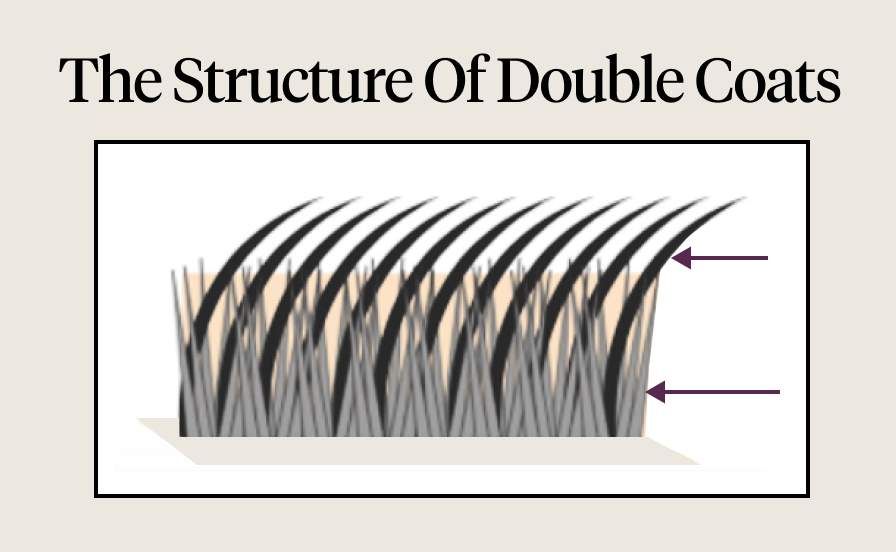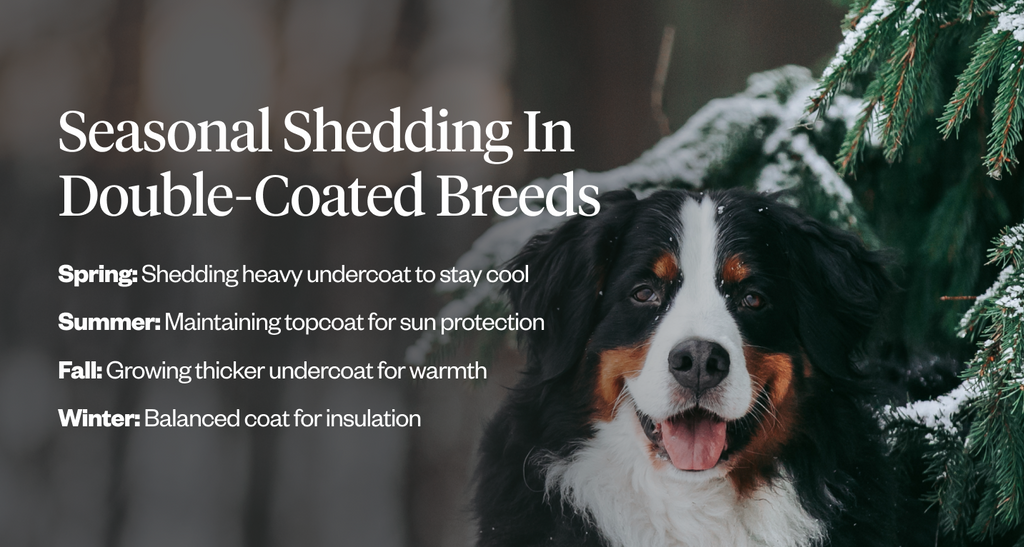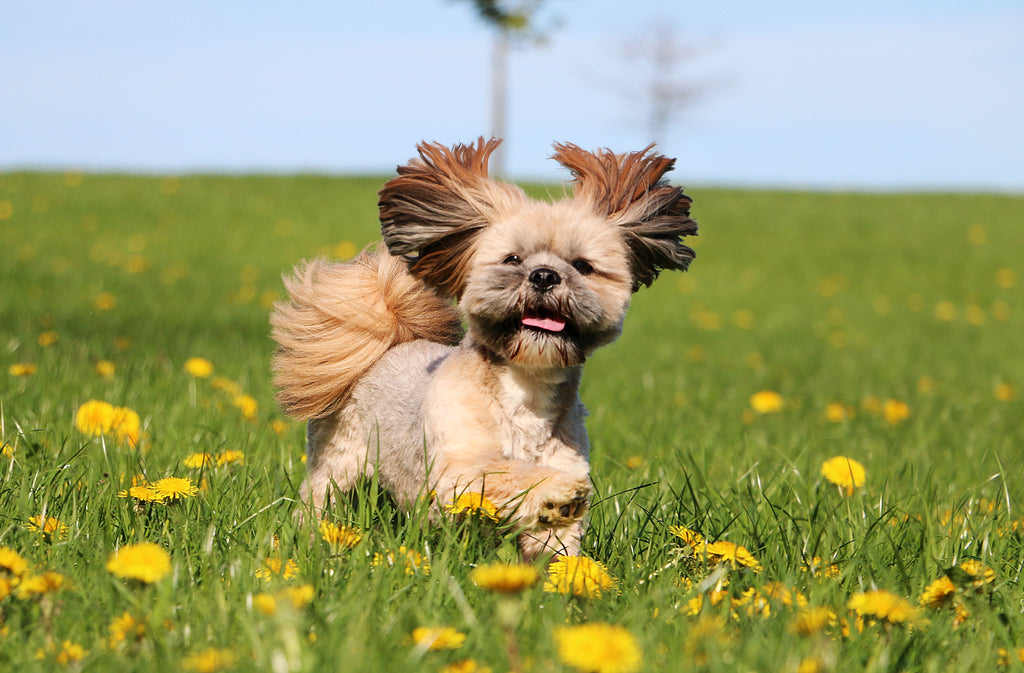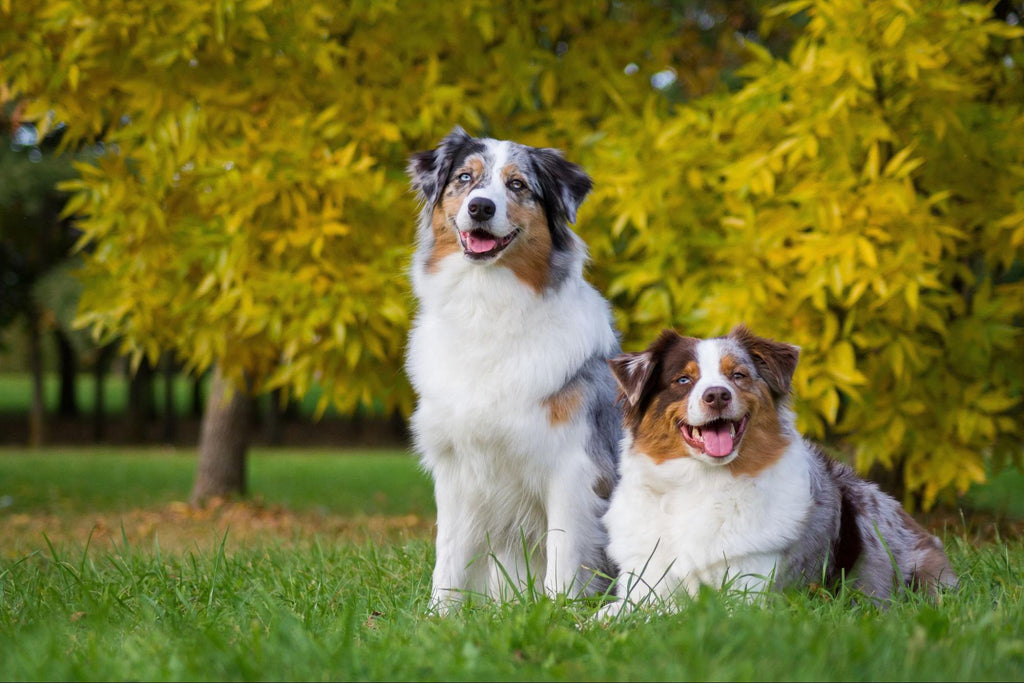14 Min Read
10 Double-Coated Dog Breeds: Grooming & Care
Key takeaway

Why pet owners are switching to online vet care with Dutch
-
Prescriptions delivered free to you
-
Fast access to Licensed Vets over video
-
Unlimited video visits and follow-ups
Caring for your dog's coat is crucial for maintaining their health and well-being. Removing dirt, debris, and dead hair allows your dog's coat to do what it does best — protect your dog from extreme weather while reducing the potential for skin infections.
If you have a double-coated dog breed, you'll need to take extra care of their coat. The double coat acts as insulation to keep your dog warm in cold temperatures and cool in cold temperatures. Neglecting to care for their coat can lead to matting and discomfort.
Grooming also allows pet parents to take a closer look at their dog's skin and coat to check for skin issues, lumps, and parasites like ticks or fleas that might be hidden underneath their thick fur. Keep reading to learn more about double-coated dog breeds and how to care for your dog's skin and coat.
- What Is A Double Coat?
- How To Take Care Of Double-Coated Dogs
- Pomeranian
- Siberian Husky
- German Shepherd
- Lhasa Apso
- Chow Chow
- Border Collie
- Leonberger
- Golden Retriever
- Australian Shepherd
- Shih Tzu
- Final Notes
What Is A Double Coat?

A double coat is a type of dog fur that consists of 2 distinct layers of fur — an undercoat and a topcoat. The undercoat is the soft, dense layer of fur that grows close to a dog's skin and provides insulation while regulating their body temperature by trapping air close to the body. 1 This undercoat is designed to keep dogs warm in cold weather and consists of a fine, downy texture.
On the other hand, the topcoat, also known as the outer coat, is the longer, coarser layer of fur that grows on top of the undercoat. It protects the skin against elements like rain, wind, bug bites, and UV rays. 1
Double-coated breeds of dogs come in a variety of sizes, shapes, and colors. Some of your favorite shaggy dog breeds have double coats, while others don't. These coats are designed to protect your dog in the heat and cold weather, so they require special attention.
How To Take Care Of Double-Coated Dogs

Double-coated dogs often shed more and usually shed heavily seasonally in the spring and fall, allowing them to make way for a new coat, depending on the season they're preparing for. Taking care of your dog's coat can help you manage shedding while ensuring your dog's skin and coat stay healthy. Here are a few tips to help you take care of double-coated dogs:
Don't shave them: While you might think shaving your dog's coat during the summer can help them stay cool, that's not necessarily true. Shaving double coats can even be dangerous for them. During the summer, your dog sheds their undercoat, allowing them to regulate their body temperature and stay cool. Shaving this fur can affect their ability to insulate themselves. 1
- Brush regularly: Brushing your dog's coat regularly — at least a few times a week — can help prevent matting, remove loose fur, and distribute their natural oils. While many dog breeds with double coats may need regular professional grooming, you can keep your dog's fur and skin healthy between sessions by brushing them at home. This also allows you to inspect their skin and coat to look for signs of infections or other issues, such as itching , rash, hives, dandruff , and so forth.
- Use the appropriate brushes: Some dog grooming brushes are specially designed for double-coated dog breeds. For instance, you can use a wire brush to help detangle fur. You can also use a shedding blade brush designed for dogs with dense undercoats. The shedding blade allows you to de-shed your dog as quickly as you can brush them. However, you should remove mats and tangles beforehand. There are also undercoat rakes to help you reach the undercoat and find dead hair that needs to be removed.
- Feed your dog a high-quality diet: Your dog should eat a high-quality diet that includes omega-3 and omega-6 fatty acids that promote healthy skin and coat. These essential fatty acids contribute to the integrity of the skin's barrier function and help to reduce inflammation, resulting in a lustrous coat. Most high-quality commercial diets should contain all the omegas your dog needs for healthy skin and coat, but discuss your options with your vet if your dog needs special dietary considerations.
- Bathe your dog regularly: How often you bathe your dog depends on their activity and where they spend their time. A dog that enjoys romping around outdoors will likely need to be bathed more than one that spends most of its time indoors. When bathing your dog, avoid using human shampoos , as these can strip your dog of their natural oils and dry out their skin. Instead, use dog-specific shampoo designed just for them and their double coats or coat type.
- Get them professionally groomed: A professional groomer has all the necessary skills and tools to facilitate seasonal shedding and improve your dog's skin and coat health. They can also provide valuable insights into the specific care needs of your dog's breed to ensure the coat remains in top condition all year long.
Pomeranian
Pomeranians are one of many small double-coated dog breeds. They're smaller versions of Arctic sled dogs named for Pomerania in northeastern Europe. These small dogs weigh between 3-7 pounds and stand at about 6-7 inches. One of their most notable features is their lush double coat with a tail that arches over their back. The coat comes in a variety of colors, from solid shades to more exotic combinations.
Pomeranians are known for their outgoing personalities. Despite their small stature, they have a bold and confident demeanor. They tend to be intelligent and fairly easy to train. They're also affectionate with their families and can be protective.
Pomeranians may be prone to certain health conditions, including dental problems. While their size makes them suitable for apartment living, they can be highly energetic and require adequate playtime and mental stimulation. 2
Siberian Husky
The Siberian husky originated from Siberia and was originally bred by the Chukchi people. This ancient dog breed played a critical role as family companions and workers, allowing them to transport goods across frozen terrains.
Siberian huskies are considered medium-sized dogs and weigh between 35-60 pounds with heights ranging from 21-24 inches. Their most recognizable feature is their almond-shaped eyes, which range in color from blue to brown and amber, with some even having heterochromia, with each eye a different color. Their double coats are medium-length, dense, and come in a variety of colors and patterns.
This breed is known for its friendly and gentle temperament. They tend to be sociable and get along well with other dogs and children. They're highly intelligent and have a playful nature. However, because they were bred for transporting goods, they have high energy levels that require regular exercise. 3
German Shepherd
German shepherds were bred as herding dogs because of their intelligence, speed, and strength. Of course, the German shepherd's abilities were quickly recognized beyond herding, leading to their use in military, police work, and other roles.
This breed stands from 22-26 inches and weighs 50-90 pounds. They have a strong, muscular build with an elongated body and a coat that's either short or medium and comes in various colors, with the most popular being black and tan.
German shepherds are known for their courage and work ethic. These highly intelligent and trainable dogs excel in advanced obedience and task-specific training. They can be protective of their families and reserved with strangers, so early socialization and training are crucial.
Like many other breeds on this list, German shepherds were bred to be workers, meaning they have high energy and require ample exercise and mental stimulation to keep them healthy and happy. German shepherds are also prone to specific health issues like hip dysplasia. 4
Lhasa Apso

The Lhasa Apso is from Tibet, with a history spanning over a thousand years. Originally bred as guard dogs for monasteries to alert the monks of intruders, this breed also held religious significance and was considered good luck.
Lhasa Apso are small dogs weighing 12-18 pounds and around 10-11 inches tall. Their most notable feature is their luxurious double coat, which is dense and straight and drapes over their bodies. It comes in a variety of colors, including black, white, and grizzle.
Despite their small size, these dogs are known for their independent natures. They're loyal and affectionate with their families but can be wary of strangers, making them alert watchdogs. 5
Chow Chow
The chow chow, known for its lion-like mane and unique blackish tongue, is an ancient breed that can be traced back over 2,000 years ago to ancient China. These dogs were used for various tasks, including hunting, herding, and protection.
The chow chow is sturdy and powerful, weighing between 45-70 pounds and standing 17-20 inches. One of its defining characteristics is its dense, smooth or rough double coat. It comes in various colors: red, black, blue, cream, and cinnamon. The breed is also known for its blue-black tongue, which contrasts its fur.
Chow chows are known for their dignified natures. They tend to be very loyal and often bond closely with their families. 6
Border Collie
The border collie is considered one of the most intelligent dog breeds in the world. This breed traces its roots back to the border between England and Scotland, where it assisted shepherds in herding and controlling sheep.
These dogs weigh 30-45 pounds and stand 18-22 inches. They're known for their beautiful coat colors and patterns, including black, white, red, and merle. The border collie is known for its intelligence and work ethic.
They excel in agility, obedience, and herding trials. While they bond with their families, their intense energy levels require them to get enough physical activity and mental stimulation to prevent boredom and potential behavioral issues.7

Leonberger
The Leonberger dates back to Leonberg in Germany around the 19th century. This breed was created to resemble a lion by crossing the Newfoundland with the Saint Bernard. The Leonberger was a working breed used for farm work, livestock management, and even pulling carts. These dogs are sturdy, weigh 90-170 pounds, and stand at 25.5-31.5 inches.
Their coat, which is long, dense, and straight, is waterproof and comes in a variety of colors, but most commonly in lion-yellow, red, reddish-brown, or a sandy hue.
Leonbergers are known for their gentle and friendly dispositions. Despite their large size, they're described as gentle giants and are loyal and form close bonds with families, even children. They're also highly sociable and tend to get along with other animals. 8
Golden Retriever
The golden retriever can trace its roots back to the Scottish Highlands in the mid-19th century when they were developed for retrieving in water and on land, which is why they're one of many dog breeds that like to swim .
This breed is robust and well-proportioned, standing at 21-24 inches and weighing 55-75 pounds. Their dense, water-repellent outer coat with a thick undercoat ranges from light golden to deep, rich gold. One of their defining characteristics is their strong, muscular build, complemented by a friendly disposition.
Golden retrievers are celebrated for their friendly, gentle, and trustworthy nature. They tend to be highly sociable, which is why so many people have them as family pets. They're also highly intelligent and eager to please, making them highly trainable. 9
Australian Shepherd
The Australian shepherd, also known as "Aussie, " didn't originate in Australia. Instead, its roots can be traced back to the Pyrenees mountains between Spain and France. Shepherds migrated to Australia and brought their dogs with them. Then, In the US, Americans were impressed with the Basque shepherds' herding abilities and began defining its characteristics to create the Australian shepherd.
Australian shepherds are slightly longer than they are tall, standing at around 18-23 inches and weighing 40-65 pounds. They have a medium-length, weather-resistant coat that's straight to wavy and comes in various colors like blue, black, and red.
This breed is known for its intelligence, agility, and high energy levels. They're highly trainable, eager to please, and excel in herding, obedience, and agility. 10
Shih Tzu
One of the smaller dogs on our list, the shih tzu — also known as the lion dog for its appearance — is a toy breed long associated with royalty. This breed dates back to ancient China, where it was believed to have been bred by Tibetan monks and given as gifts.
The shih tzu stands at just 9-10.5 inches and weighs between 9-16 pounds with a sturdy build and broad rounded head with a distinct short muzzle. One of its most defining characteristics is its long, luxurious, dense double cat, which comes in various colors.
These dogs tend to be affectionate, outgoing, and friendly. They're often adaptable and can be happy living in an apartment. While they enjoy moderate exercise and play, they're also happy lounging on the couch with their favorite humans. 11
Final Notes

Double-coated dog breeds have a distinctive fur structure that protects them from dirt, debris, and harsh weather. Caring for these coats is crucial. Regular grooming removes shed hair, prevents matting, and ensures the coat remains in good condition. By staying attentive to your dog's grooming needs, you can reduce the risk of infection and ensure the coat continues to do its job well.
Every dog is different. Beyond their fur, every dog has a unique personality, specific dietary requirements, and individual health concerns. Regardless of their fur type, each dog deserves quality care tailored to its unique needs. Try Dutch today to ensure your canine companion receives the best care and advice from the comfort of your home.
Share
References
-
Meyers, Harriet. “Is It OK to Shave Your Dog’s Coat in Summer?” American Kennel Club, American Kennel Club, 6 July 2023, www.akc.org/expert-advice/health/is-it-ok-to-shave-your-dog/.
-
“Pomeranian Dog Breed Information.” American Kennel Club, 6 Nov. 2017, www.akc.org/dog-breeds/pomeranian/.
-
Kriss, Randa. “Siberian Husky Dog Breed Information.” American Kennel Club, 6 Nov. 2017, www.akc.org/dog-breeds/siberian-husky/.
-
Greenberg, Aurora. “German Shepherd Dog Dog Breed Information.” American Kennel Club, 6 Nov. 2017, www.akc.org/dog-breeds/german-shepherd-dog/.
-
Young, Sean. “Lhasa Apso Dog Breed Information.” American Kennel Club, 6 Nov. 2017, www.akc.org/dog-breeds/lhasa-apso/.
-
Pessah, Steve. “Chow Chow Dog Breed Information.” American Kennel Club, 6 Nov. 2017, www.akc.org/dog-breeds/chow-chow/.
-
Kriss, Randa. “Border Collie Dog Breed Information.” American Kennel Club, 6 Nov. 2017, www.akc.org/dog-breeds/border-collie/.
-
Young, Sean. “Leonberger Dog Breed Information.” American Kennel Club, 6 Nov. 2017, www.akc.org/dog-breeds/leonberger/.
-
Greenberg, Aurora. “Golden Retriever Dog Breed Information.” American Kennel Club, 6 Nov. 2017, www.akc.org/dog-breeds/golden-retriever/.
-
Latimer, Matt. “Australian Shepherd Dog Breed Information.” American Kennel Club, 6 Nov. 2017, www.akc.org/dog-breeds/australian-shepherd/.
-
Kriss, Randa. “Shih Tzu Dog Breed Information.” American Kennel Club, 6 Nov. 2017, www.akc.org/dog-breeds/shih-tzu/.

